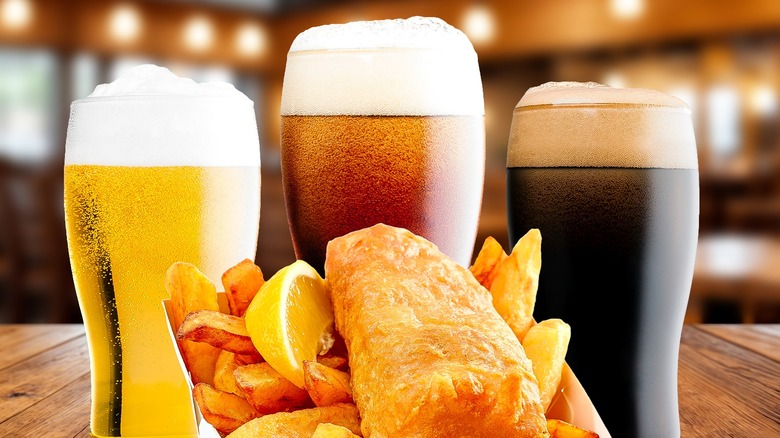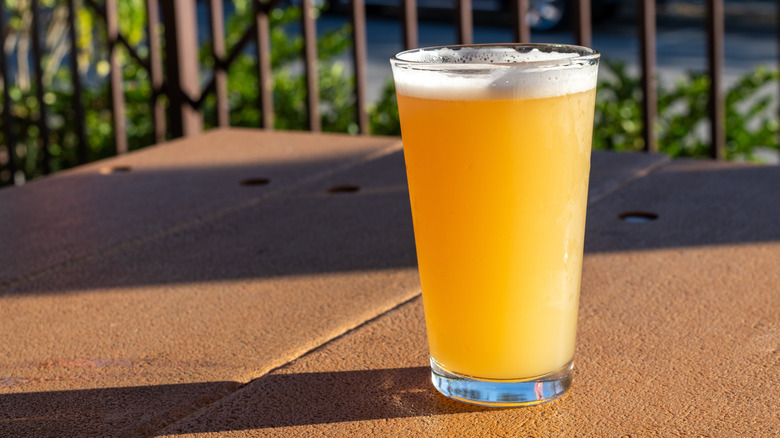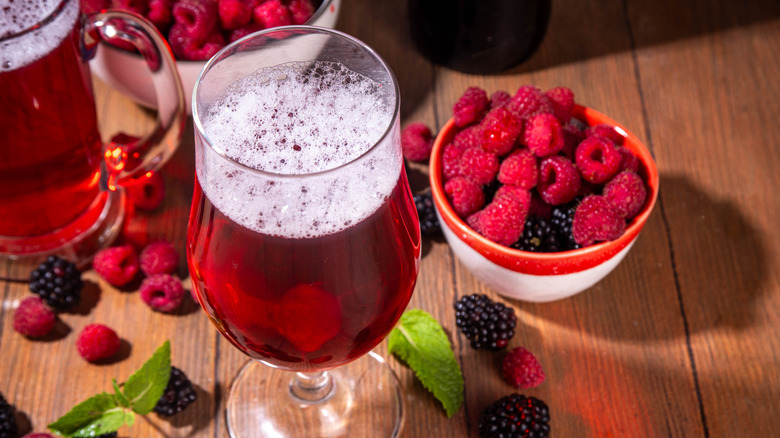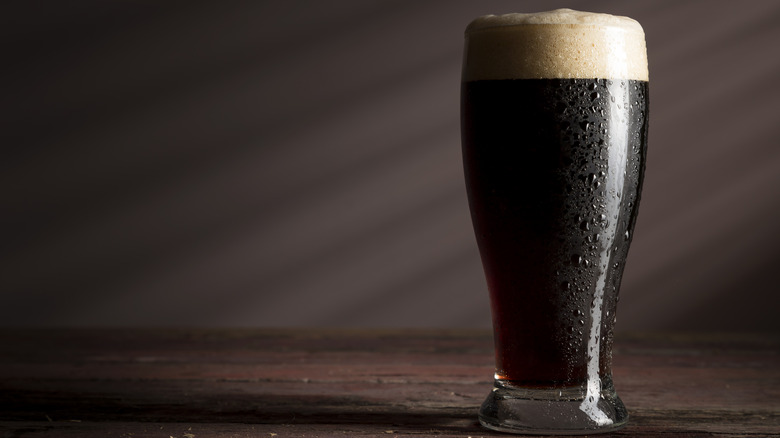7 Best Beers For Battering Fish And Chips And 3 To Avoid
We may receive a commission on purchases made from links.
Breading is a popular feature of seafood, whether a delectable crust of potato chips or a paper-thin tempura coating. But when it comes to fish and chips, Britain's defining street food calls for a batter to hold up to the golden-brown glory. You guessed it: beer batter. Batter usually contains ingredients like flour, cornstarch, baking soda, and wet components like egg and water. A crisp ale in the mix lends extra dimension and a hint of flavor that permeates the cod, halibut, or haddock filets.
There are distinct reasons to incorporate beer into deep-fried dishes like this — mainly, for texture. The drink is fermented with yeast, and due to the methods used during brewing, it builds up carbonation. When the coated filets make contact with the hot oil, the fizzy suds and bready aromas activate, forming a shell over the flaky fish that's extra crisp and crunchy. And who can argue against sipping the rest of the beer while you cook?
Frustratingly for home cooks, recipes for homemade beer batter can be vague. They will list beer as an ingredient, yet they won't specify what variety or style to reach for. Perhaps that means you don't have to be very picky about what you pour in. But from the experts' standpoint, a problematic brew can make your beachside-style feast flounder. Check out some of the best beers for the job, as well as the types to (generally) skip.
German Pilsners
Those unsure about which brew garners the tastiest crunch have plentiful options to select from. And from the looks of it, German Pilsners are a must to have in your frying setup. Hoppier characteristics and a slight bitterness distinguish pilsners from lagers, but generally speaking, they're one and the same. They harbor aromas of malt and earthy undertones, yet the complexity is balanced by smoother, palate-coating characteristics. You'll know this pint by the refreshingly crisp taste and plentiful bubbles, both crucial to the task of battering your fish to plump, browned perfection.
Chef Howie Haywood from Blackmoor Bar + Kitchen, a brewpub in Charlestown, Massachusetts, is big on the Rothaus Pils for its premium battering capabilities, but just about any beer of this type will render a good golden finish. This pilsner, which is brewed in the Black Forest region, touts Noble hops prized for their nuance and purity. As a result of the subtler aromas, the coating is nice and toasty, but "doesn't overpower the fish flavor," according to Haywood. The lower ABV (in this case, 5.1%) is also a plus for preventing overcooking. Since the booze cooks off more quickly than other liquids, your fish will retain a flaky tenderness while helping the batter cling on and not fall apart.
Brown Ales
Fish and chips are beloved worldwide, but there is no doubt the United Kingdom reigns supreme in its devotion to the pairing. So in the spirit of tradition, why not lean into the dish's British roots by buying, you guessed it, a British beer? It's true that brown ales achieve a more flavorful stew, but they offer some fantastic benefits for nailing a blissful fish batter. These bottles lean sweeter than the aforementioned lagers and are richer in hue to boot. But the way the malts and barley yeast are utilized provides a warmer finish, giving way to that amber-y brown shell characteristic of fried fish. This variety ranges between notes of honey, toasted bread, and nuts, and as such makes it a pleasant choice if you prefer some depth in your coating.
Plunging your filets in brown ale will give them great color and texture, but its performance does depend on the beer's rap sheet. Look for the easy-drinking kind, as this will score better on the frying scale than beers hosting high-octane ABVs. Newcastle Brown Ale is the prototype of this style, but there are similar bottles in the market from Samuel Smith and Brooklyn Brewery.
American Lagers
If you want a beer that responds well to beer batter, the first step is to skip the craft stuff — imperial, extra-hopped, or hazy — as this will throw off the taste. Instead, reach for the American lager. Are we seriously suggesting the cheap cans you guzzle down before the big game? You bet we are. Besides the rapid carbonation, they boast a pale profile that tastes bread-like and plenty yeasty, which will impart a lovely gold finish to your batter. Fiona Lewis, who runs The District Fishwife in Washington, DC, finds these brews exemplary in creating a coating that's both airy and extremely crunchy. "To keep the batter light, what we're really looking for are big bubbles," she said. "So if the beer is a low fizz, it's not ideal."
Your standard-issue cold ones are great for unpretentious swilling, but what they have in common is belonging to the beer family best positioned for frying success. Major institutions like Coors, Budweiser, and Miller High Life, fit the bill for their accessibility, on top of the light-bodied traits guaranteeing a good, golden crust. On the international stage, bottles like Heineken or Peroni boast favorable bubbles for the job as well. "The high carbonation from the fermentation creates a very light and crispy batter," explains James Sawyer, whose establishment Rí Rá Irish Pub leans on an award-winning option: good ol' Pabst Blue Ribbon.
Golden and Blonde Ales
Think about what you want to get out of frying up fish and chips. The primary goal should be two things: fish that melts in your mouth, and a coating that is ultra-crisp and craggy. Wowing the tastebuds, then, is only a matter of time when you mix the right beer into your batter. You can't go wrong with golden or blonde ales for the job. They're touted for their smooth drinkability and proffer sublime qualities for infusing color, depth, and crunch.
The stronger hop aromas are less prominent compared to other styles, with the notes traversing the honeyed and citrusy to bursts of spice and even caramel. The pendulum swinging between bready funk and bright sweetness livens up the batter so that it retains great flavor and an airy crispness. Additionally, we can't ignore the close similarities to the fish and chip garnishes that are a must for this dish, like the zesty lemon wedge and malt vinegar. Ultimately it's refreshing and bright on the palate and explains why many beers in this camp get heavy billing during the summer months.
Don't get too hung up on the name. The distinction relates to geography, but essentially you want to look for something light and fizzy, regardless of what's on the label. Pelican Brewing's Sunrise Surfer and Kona Brewing Co.'s Big Wave are excellent contenders.
Czech-Style Pilsners
Battering fish and chips yourself takes practice, but aside from flexing the right techniques (and proper equipment like a deep fryer), home chefs shouldn't overlook the punch the right beer can bring. Czech Pilsners are another style that strikes gold for a good batter and deserves your consideration. Much like its German counterpart which we touched on already, it retains a balanced ratio of malts and hops. However, the mellower undertones distinguish it from the head-strong aromas of other pilsners, and that will retain a good foundation for permeating your batter coating.
Howie Haywood of Blackmoor Bar + Kitchen attests to this style, and one variety he praises comes from a local Massachusetts brewery. The Czech Pils from Notch Brewing is a fresh sipper lifted with Saaz hops, malts, and ample amounts of suds, offering a three-way punch to a golden-brown batter. The market is full of options, so tapping one at your preferred beer supplier should be an easy feat. Most retailers will carry an array of commercial and microbrew options, which include Mama's Little Yella Pils from Oskar Blues or Sierra Nevada's Summerfest.
Amber Ales
Amber ales are fantastic thirst-quenchers. A salve for hot hazy days, they're lush and creamy, making them a dream to wash down while sunbathing at the beach. No wonder cooks reach for the golden elixirs to jazz up a fish-fry basket. Integrating this beer into your fish and chips will take your brown coating to the next level; the malty disposition adds interest, and plentiful air bubbles will incite those craggy peaks, helping to fry the fish faster than the other wet components (yes, even more than water). Add in the faint herbal flourishes distinguishing this style, and you'll arrive at a lip-smacking batter awash in multi-faceted flavor.
Traditionally, amber ales are not the sort of beer meant to induce hangovers the next day; they fluctuate between 4% and 6% ABV, although the number can vary by bottle and brewery. This is the ideal. It's the meager booziness that renders better texture in your fish overall, so go low when scouting out your particular can. One variety meeting the qualifications is Bell's Amber Ale, which forges prominent malts and a blend of fruity yet roast-y undercurrents.
American Pale Ales
Funnily, it's beer's fizzy attributes — not necessarily the flavor — that draw cooks to implement it as a batter ingredient. On the other hand, when has it ever hurt beer-battered fish and chips to go for the jugular, palate-wise? American Pale Ales come at the suggestion of chef Howie Haywood from Blackmoor Bar + Kitchen, upping the ante for your beer batter, and it's not hard to see why. As a standalone beverage, they are extremely versatile, while the fragrant, juicier leanings lend something special in the context of savory entrees. When you think of microbreweries at large, this is the draft most will pour daily.
As a "pale ale," it lives up to the name. But don't write off the drink as a lightweight. Drenching your fish in it will draw out myriad aromas — a little hoppy, a little fruity — but tethers between the two equally, granting a mouthfeel that's quite pleasant and fragrant. Although the profile can be brisk, it isn't going to transfer to a harsh-tasting crust encasing the pub staple. Seek out something like Mirror Pond Pale Ale from Deschutes Brewery to try. It sources hops in the Pacific Northwest to conjure a refreshingly vibrant brew.
Avoid: IPA's
On the topic of beers to avoid, our experts showed consistent overlap with what to steer clear of. Be wary of beers that are overly bitter or strong when selecting one to use in your batter. Indian Pale Ales (IPA's) retain bolder characteristics in the realm of hops and additives, and can tout higher-than-average amounts of alcohol. To no surprise, this makes them a favorite among microbreweries and they pair swimmingly with spicy foods. But when it comes to the prospect of frying fish, those extreme sensory elements don't lend themselves to a pleasing concoction to dredge your seafood in.
The unapologetic strength in a standard IPA formula doesn't come by accident, they're brewed that way on purpose. The in-your-face character is credited to the practice of fermenting hops at the beginning and the end of brewing. Seafood is delicate overall, and this fact comes to life when submerged in a hot vat of oil. But even with meatier varieties your average fish and chip recipe is made with, the astringency ends up dominating, rather than complimenting, the fish at hand.
Avoid: Fruity and Sour Beers
Similarly, brews in the sour or fruity arena should be skipped as you set about frying your fish. Part of what allows beer batter to flourish is the faint whiff you catch within the coating — a light, fermented scent. Pouring in a mouth-puckering Gose or raspberry ale might seem inventive at first, but as chef James Sawyer of Rí Rá Irish Pub told us, the tart profiles will not cooperate as they should. Rather, these kinds of flavors will clash against the bread-like elements in the batter. And if that weren't enough, our expert says these fragrant ales also interfere with how your seafood will taste out of the fryer to boot. "The heavy malt flavor will overpower the fish," he said.
When it's a beer you're downing on the side, the potential pairings can certainly welcome a little wiggle room in this area. Citrus, particularly lemon, is very inviting as a contrast to salt-laden batter, so don't hesitate to sip this in terms of an accompaniment. But we can't, in good faith, recommend them as an ingredient. Unless you want the weird aftertaste of tropical punch in your crust, sticking to the traditional pour-ins is best for your batter's potential.
Avoid: Stouts and Porters
In terms of sipping, porters and stouts go beautifully with a delicious fish fry. But in a batter, Rí Rá Irish Pub's James Sawyer says the decadent style just doesn't pass the test. Dark beers of this strain share that milky foam head, but the body is noticeably lacking in carbon dioxide, which will not give your battered cod the desired snap when biting into it. Predictably, the coating will harbor a darker hue, not the toasty shade of brown we look for in fish and chips, and the stronger flavor is simply too much. Batter should complement, not dominate, the filets at hand, and beers of this strain will create a heavier coating than anticipated.
Alternately, Fiona Lewis of The District Fishwife argues there's a place for darker brews in deep-frying, and we can understand the reasoning. The richer style is unconventional within battered dishes, which might appeal to iron-tongued foodies wanting a change from the norm. And even lighter versions (take Guinness, for instance) demonstrate a flexibility, so long as the profile is gentler. But if you're not super well-versed in such beer styles, it might be better to savor it on the outside — paired with deep-fried mushrooms, for instance — and leave it out of your batter altogether.










